Museums in the Funny Papers |

|
A selective survey of museums in comic strips, comic books, and graphic novels
- The Casey Corner Kids' Dime Museum, New York (Richard F. Outcault, "Hogan's Alley")
Richard Outcault's "Hogan's Alley" was one of the of the very first comic strips, chronicling the antics of New York street urchins during the Gilded Age. Its hero, The Yellow Kid, was a bucktoothed child invariably dressed in an overlarge yellow shirt. On May 1, 1898, a wizened version of the Kid opened his own museum in the tradition of P.T. Barnum. The exhibits consisted mainly of living sideshow gaffs, but also included a "genuine feline cat" to illustrate the point that "a cat is really wonderful when you stop to think - anything is - on careful consideration!"

- Paleontology Museum, Coconino County (George Herriman, "Krazy Kat")
"From the mires of the Miocene, from the silts of the Silurian, from the jungles of the Jurassic...glommed from the cradle of time - when geology was green - and from the clays of the Cambrian, from the drifts and delirium of the Devonian, from the moil and muds of the Mesozoic..."
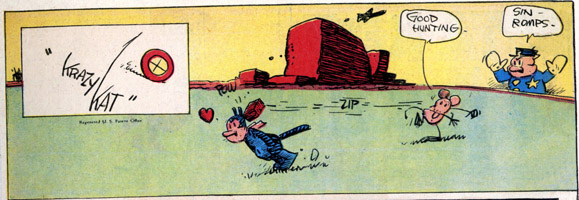
March 6, 1938 - Source: George Herriman's Krazy Kat: A Celebration of Sundays
Far from New York's muddled masses, the Museum of Paleontology (and Archeology and such) of Coconino County sits in the middle of George Herriman's dreamy version of the American Southwest, a land of shifting geology, curious potted plants, and its own dialect. The surreal landscape changes constantly, but the plot stays the same: Ignatz Mouse has an uncontrollable urge to bean Krazy Kat with a brick; the Kat takes this as a welcome sign of affection; Offisa Pupp takes a dim view of the proceedings and throws the miscreant rodent in jail. After some thirty years of this, the trio comes upon a museum whose only apparent exhibit indicates that this fundamental relationship has remained unchanged over millions of years of evolution. Read the full story here

- The Fort Mudge Memorial Dump, Okefenokee Swamp (Walt Kelly, "Pogo")
In contrast to the spare desert minimalism of Coconino County, the Okefenokee Swamp is a teeming jungle of venerable trees and a huge population of animals, speaking their own southern patois and constantly getting into slapstick scrapes. Even the worms and insects there have their own personalities. In this Sunday strip, "Perfessor" Howland Owl, the resident intellectual, reveals his grand plans for a museum. The dream is never realized, but Owl does later land the prestigious position of Curator at the Fort Mudge Memorial Dump, tending its vast collection of decaying objects and eventually founding its library. Click on any image for the full story.
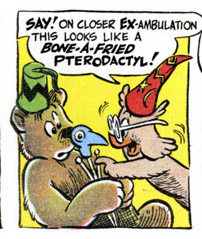
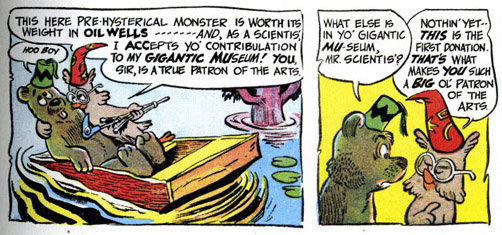
May 13, 1951 - Full page
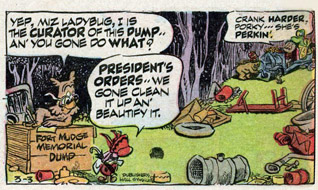
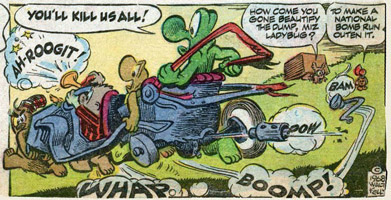
March 3, 1968 - Full page - Source
"President's orders" refers to the Highway Beautification Act of 1965, presided over by Lady Bird Johnson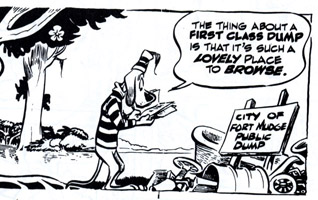
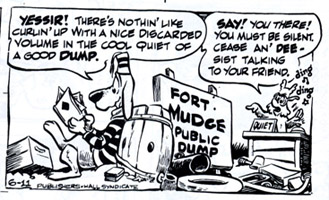
June 11, 1972 - Full page
- The Art Museum vs. the Natural History Museum (Bill Watterson, "Calvin and Hobbes")
In addition to its teeming cities and vast tracts of desert and swampland, America boasts great swaths of residential suburbia where children historically have had little to do except watch television and lead rich imaginary lives. If they were lucky, there were woods nearby that they could explore. One such child is Calvin, a 6 year old boy with no surname living in an unnamed town.
There are two (unnamed) museums in Calvin's life, symbolizing the split between art and science that occurred as specialized museums evolved out of the early curiosity cabinets that mixed naturalia and artificialia. The art museum inspires him to create his own sculptures from the most basic of natural materials, a sort of precocious postmodernism.


Feb 21-22, 1990
In contrast to the cerebral world of art, the natural history museum connects Calvin with his primordial inner beast.


August 9 & 11, 1989
One day, the art museum and the natural history museum collided with cataclysmic results. Read the full story here
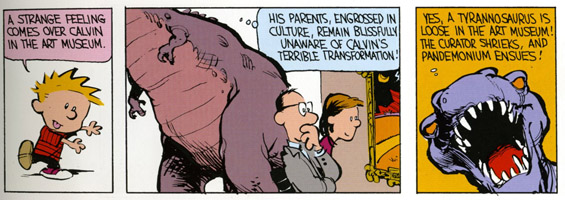
May 17, 1987 - Full page
Note the reference to Coconino County in the middle panel.
For more of Calvin's snow art, see here- Shoebox dioramas (Richard Thompson, "Cul-de-sac")
Shoeboxes are ideal for the casual diorama-maker. 7 year old Petey Otterloop takes the medium to new heights with his ambitious project to encompass all of human history in shoeboxes.


May 23 & 25, 2009 - Full series
-
- Superman's museum at the Fortress of Solitude
Superman's personal museum was located in the frozen wastes of the north and could only be opened with a giant key that only he could lift. It included an alien zoo, souvenirs of his exploits and his trips to exotic places, and, most notably, an entire city in a bottle. It also included a "rainbow jewel from another planet" which inspired object #1 of the Zymoglyphic Museum. His museum was normally a very private space. However, on one occasion, he opened the museum to visitors by bringing it bodily to Metropolis.
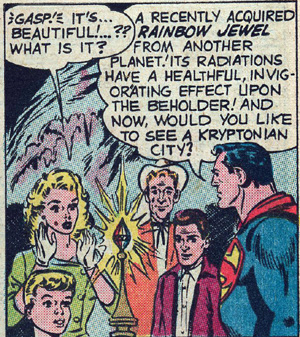
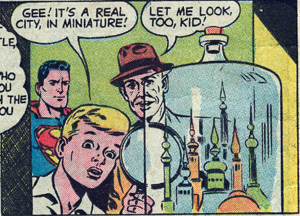
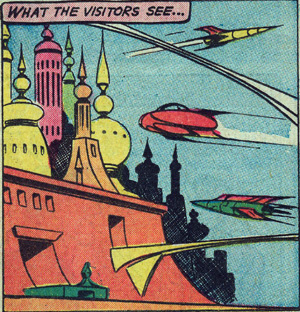
Action Comics #261 (Feb. 1960) - Related blog entry on the rainbow jewel
- Museums in the Unifactor (Jim Woodring)
The Unifactor is a minor continent of the collective unconscious, a wondrous nightmare world where a "gormless mogomorph" named Frank wanders in bewilderment, curiosity, amusement, and sometimes terror. On occasion he finds himself lost or trapped in a museum filled with enigmatic exhibits, a microcosm eliciting the same mix of emotions.
Jim Woodring grew up in in the Los Angeles area and remembers being fascinated by the Griffith Observatory, the LA Natural History Museum and others. He calls them "palaces of poetry and wonder."
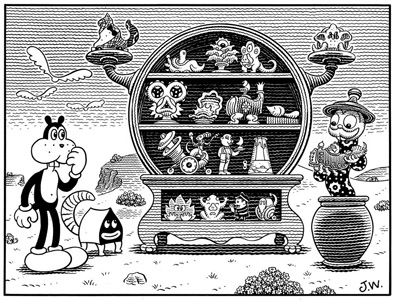
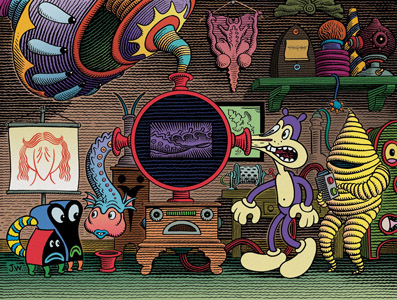
Left: Frank and the Collector - Source
Right: An interactive exhibit from The Museum of Love and Mystery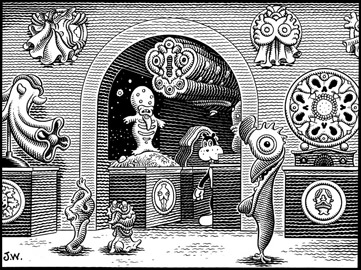
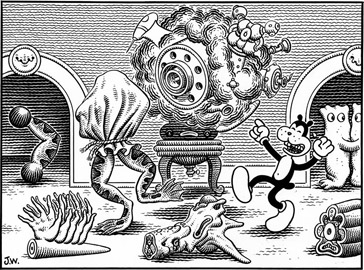
Left: Frank Hunts for the Exit - Source
Right: Frank Gets the Joke - SourceManhog is another citizen of the Unifactor, although his experience of it is generally more negative than Frank's. Of the following image, Woodring says "[The image] depicts...the plight of poor old Manhog who finds himself the prisoner of malevolent entities in a closed museum. His faith in the power of art to liberate him from impending disaster is just so touching!"
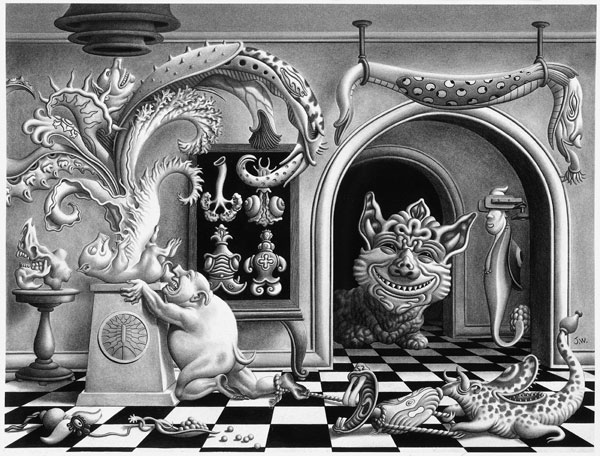
The Holy Land - Source